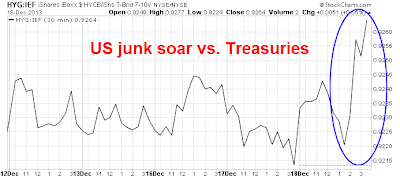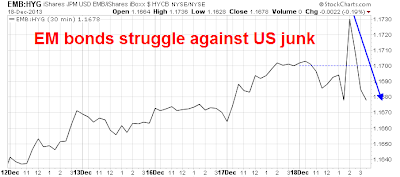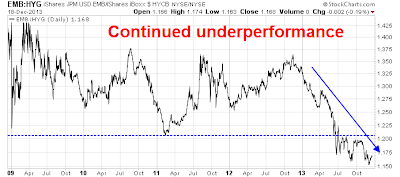by Cam Hui, Humble Student of the Markets
To be honest, I did not expect a December taper. That's because there was no consensus at the Fed as to what kind of forward guidance language to give Mr. Market so that it wouldn't freak out. The Fed had made it clear that "taper is not tightening". In light of the market reaction in the May-September period over the possibility of tapering, the Fed had to make it clear that they did not want forward rates to rise significantly. One alternative was to state that they would lower the unemployment threshold range before considering raising short-term rates, another was to explicitly target inflation, etc. There appeared to be no consensus.
What emerged was this compromise sentence in the FOMC statement, which appeared to spark the stock market melt-up:
The Committee now anticipates, based on its assessment of these factors, that it likely will be appropriate to maintain the current target range for the federal funds rate well past the time that the unemployment rate declines below 6-1/2 percent, especially if projected inflation continues to run below the Committee’s 2 percent longer-run goal.
We now have an inflation target in the guidance language, sort of.
What about the risk premium?
The FOMC statement had also raised economic growth and lowered unemployment projection for 2014, which is bullish for the economy and the stock market. Under conditions of rising economic growth, rising long rates should not be an impediment for stock prices because of the underlying support of rising growth and rising earnings.
While that is true of a typical cyclical recovery from a recession, current conditions are unusual because it is a recovery from a balance-sheet recession where deleveraging is occurring. Moreover, the Fed's QE programs have served not only to lower interest rates, they compressed risk premiums across the board (see It's the risk premium, stupid!).
So what happens now to the risk premium?
Rising EPS vs. normalizing risk premiums
Here is my concern. The response of stock prices to rising EPS is linear, while the response to changes in risk premium is non-linear.
Here is what I mean. Consider that if EPS rises 10% and the P/E ratio stays the same, stock prices will rise 10%. However, if the discount rate, or capitalization rate, on expected future earnings changes by 100bp, and the change consists of a combination of rising interest rates, e.g. 25bp, and rising risk premium, e.g. 75bp, then prices can change considerably.
The chart below graphically shows capitalization rate on the x-axis and the P/E ratio on the y-axis (P/E = 1/cap rate). Note how the line is depicted as a curve. A minor change in the discount rate can affect the P/E ratio disproportionately. When rates is low, a small rise in capitalization rate results in a precipitous drop in the P/E ratio.
Even if EPS rises, a Fed taper whose market reaction includes rising risk premium, can result in conditions where stock prices fall because the positive effects of rising earnings are offset by the negative effects of falling P/Es.
I am therefore carefully watching credit spreads, both in the US and globally, to how the market perceives the Fed's decision to taper. Will the risk premium rise? By how much and in what sectors? During the May-September "taperitis" period, the Fed's announcement that it was considering tapering caused emerging market bond yields to blow out and nearly resulted in an EM currency crisis.
The initial market reaction has been positive. Across the Curve describes the reaction as "financial nirvana":
Credit Spreads are on fire or as our Spanish friends would say “en fuego”. Bank and finance paper is better by 3 basis points to 5 basis points but in the 7 year and 8 year part of the curve paper is as much as 8 basis points tighter. TMT (telecom media and technology) is 3 basis points to 4 basis points better. Stocks are rallying huge and the funds rate will be at zero for the rest of out lives and maybe even our supernatural lives. So what is there to worry about as this is financial nirvana.
Consider the market reaction, which bears close monitoring in the days and weeks to come. In the wake of the Fed announcement, the relative performance of US junk bonds (HYG) soared against 7-10 year Treasuries:
EM bonds (EMB) rallied against US junk (HYG), but they faltered later in the day:
Here is the longer term chart of EM bonds relative to US junk. EM bonds never recovered from taperitis, which is a concern given the interconnected nature of the global financial system.
Watch this space! If EM spreads were to start reversing themselves and start blowing out, then the contagion could potentially spread to other markets and the result would be a catastrophic market sell-off.
Cam Hui is a portfolio manager at Qwest Investment Fund Management Ltd. (“Qwest”). The opinions and any recommendations expressed in the blog are those of the author and do not reflect the opinions and recommendations of Qwest. Qwest reviews Mr. Hui’s blog to ensure it is connected with Mr. Hui’s obligation to deal fairly, honestly and in good faith with the blog’s readers.”
None of the information or opinions expressed in this blog constitutes a solicitation for the purchase or sale of any security or other instrument. Nothing in this blog constitutes investment advice and any recommendations that may be contained herein have not been based upon a consideration of the investment objectives, financial situation or particular needs of any specific recipient. Any purchase or sale activity in any securities or other instrument should be based upon your own analysis and conclusions. Past performance is not indicative of future results. Either Qwest or I may hold or control long or short positions in the securities or instruments mentioned.
Copyright © Humble Student of the Markets



















